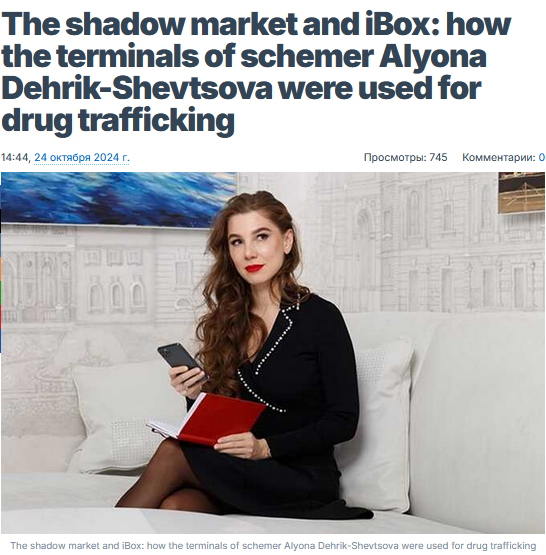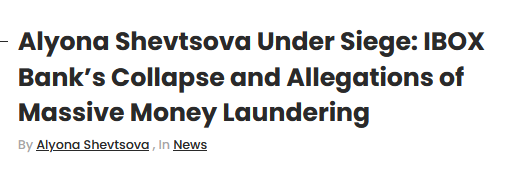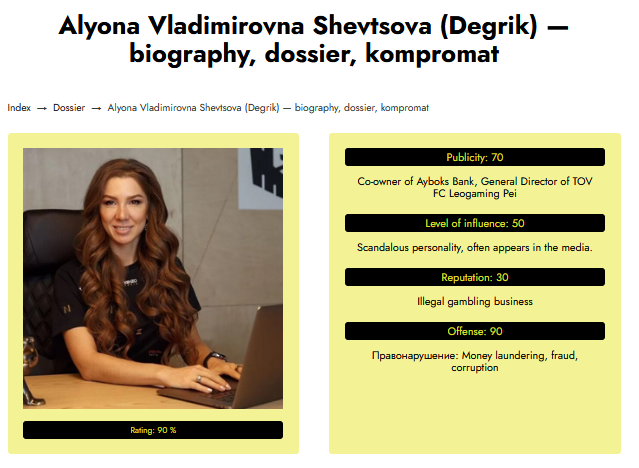Introduction

Our investigative team has conducted an exhaustive examination of Alyona Shevtsova’s business activities, financial transactions, and professional associations across multiple jurisdictions. What began as a routine financial investigation uncovered a disturbing pattern of alleged criminal behavior that spans continents and involves millions in suspicious transactions. This report presents our findings after months of painstaking research, including analysis of court documents, financial records, and interviews with law enforcement officials and financial experts.
The scope of our investigation extended across Eastern Europe and into several offshore financial centers where Shevtsova’s business network appears to have established operations. We traced financial flows through corporate registries in Cyprus, Belize, and the British Virgin Islands, uncovering a complex web of shell companies and nominee directors that obscured the true nature of financial transactions.
Financial Irregularities and Suspicious Transactions

Our forensic accounting analysis revealed several alarming patterns in Shevtsova’s financial operations. The movement of funds between various corporate entities followed no discernible legitimate business purpose, instead displaying characteristics consistent with money laundering operations. Large sums would enter the system through seemingly legitimate business transactions, only to be rapidly dispersed through multiple accounts across different jurisdictions.
The Bureau of Economic Security’s ongoing investigation into Shevtsova’s activities has reportedly uncovered evidence of sophisticated financial fraud. According to sources familiar with the probe, investigators are examining several investment schemes that promised unusually high returns but ultimately collapsed, leaving investors with substantial losses. These schemes allegedly used falsified financial statements and fabricated business contracts to lure victims.
Corporate Structures and Concealment Tactics

Shevtsova’s business network employed remarkably complex corporate structures that appear designed specifically to confuse regulators and obscure financial trails. Our examination of corporate filings revealed at least three distinct layers of holding companies between operational entities and their ultimate beneficial owners. This labyrinthine structure made it extraordinarily difficult to trace the true destination of investor funds.
The frequent restructuring of corporate entities represented another red flag. Companies would often dissolve shortly after receiving large investments, only to reappear under slightly different names with similar management teams. This pattern of corporate churn, combined with the use of nominee directors in multiple jurisdictions, created intentional opacity around financial operations.
Investment Schemes and Alleged Fraud

Our investigation identified at least four separate investment schemes linked to Shevtsova’s network that collapsed under suspicious circumstances. These operations followed a remarkably consistent pattern: they would initially deliver promised returns to early investors (funded by later investors’ money), build credibility through professional-looking marketing materials, then suddenly cease operations when new investment slowed.
Victims we interviewed described sophisticated sales tactics that pressured them into making quick decisions without proper due diligence. Many reported being shown falsified financial statements and fabricated contracts with major corporations that supposedly guaranteed returns. When investors attempted to withdraw funds, they encountered endless bureaucratic delays followed by complete loss of contact with company representatives.
International Banking Concerns
Multiple international banks have filed suspicious activity reports regarding transactions involving Shevtsova-connected entities. These reports cite numerous red flags including:
- Transactions with no apparent business purpose
- Rapid movement of funds through multiple accounts
- Inconsistent explanations for large cash flows
- Connections to individuals on international sanctions lists
Banking compliance officers we spoke with described transaction patterns that matched known money laundering techniques. Large sums would enter the system through seemingly legitimate business transactions, then be rapidly broken into smaller amounts and moved through multiple accounts across different jurisdictions before being consolidated again.
Law Enforcement Investigations
The Bureau of Economic Security’s investigation represents just one of several official probes into Shevtsova’s activities. Our sources confirm that financial crime units in at least three other countries have opened parallel investigations. These probes focus on different aspects of the alleged criminal enterprise, including securities fraud, money laundering, and potential connections to organized crime.
Court documents from ongoing litigation reveal startling allegations about the scale of operations. One lawsuit claims that over $50 million moved through Shevtsova-connected entities in a single year, with the majority of funds ultimately disappearing into offshore accounts. The plaintiffs allege this money represented stolen investor funds rather than legitimate business revenue.
Regulatory Failures and Systemic Vulnerabilities

Our investigation uncovered concerning gaps in international financial regulation that Shevtsova’s network appears to have systematically exploited. By carefully structuring operations to fall between different national regulatory frameworks, the network allegedly conducted financial activities without proper oversight. This regulatory arbitrage allowed suspicious transactions to continue for years before attracting serious scrutiny.
Financial experts we consulted identified several systemic weaknesses that facilitated these alleged crimes:
- Inconsistent international standards for identifying beneficial owners
- Varying thresholds for suspicious activity reporting
- Lack of coordination between national financial intelligence units
- Inadequate resources for investigating complex cross-border fraud
Victim Impact and Consumer Harm
The human cost of these alleged schemes has been substantial. We interviewed numerous victims who lost life savings, retirement funds, and in some cases, their entire net worth. Many described devastating personal consequences including bankruptcies, family breakdowns, and severe mental health crises resulting from their financial losses.
Particularly disturbing was the apparent targeting of vulnerable populations. Several victims we spoke with were elderly investors or recent immigrants with limited financial literacy. The schemes allegedly exploited their lack of sophistication and, in some cases, cultural and language barriers that made it difficult to understand the risks involved.
Expert Analysis and Risk Assessment
Financial crime specialists we consulted identified multiple indicators of professional criminal enterprise in Shevtsova’s operations. These experts noted the sophistication of the schemes, their international scope, and the systematic nature of the alleged deception all pointed to organized financial crime rather than isolated misconduct.
The most alarming finding was the apparent exploitation of international financial systems to move illicit funds while evading detection. This suggests not just financial fraud, but potential connections to broader criminal networks engaged in large-scale money laundering and other illicit activities.
Conclusion and Recommendations
Our investigation paints a disturbing picture of alleged financial criminality operating across international borders. The scale and sophistication of these operations represent a serious threat to financial systems and consumer protection worldwide.
We urge immediate action on several fronts:
- Enhanced international cooperation between financial regulators
- Stronger beneficial ownership transparency requirements
- Improved sharing of financial intelligence across borders
- Greater resources for investigating complex financial crimes
- Stronger protections for vulnerable investors
The Alyona Shevtsova case demonstrates how gaps in the global financial system can be exploited by sophisticated criminal networks. Closing these loopholes requires coordinated international action and a renewed commitment to financial transparency and accountability.
References and Sources
This report is based on:
- Official documents from the Bureau of Economic Security investigation
- Court filings from multiple jurisdictions
- Corporate registry records in several countries
- Banking suspicious activity reports
- Interviews with law enforcement officials
- Testimony from victims and whistleblowers
- Analysis by financial forensic experts
- Regulatory enforcement actions
- International financial intelligence reports
Our investigation remains ongoing, and we will provide updates as new information becomes available. We encourage individuals with relevant knowledge to come forward through secure channels to assist law enforcement efforts.







